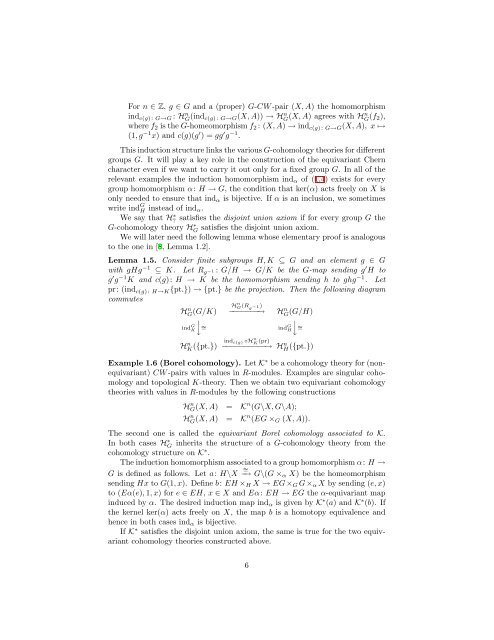Equivariant Cohomological Chern Characters
Equivariant Cohomological Chern Characters
Equivariant Cohomological Chern Characters
You also want an ePaper? Increase the reach of your titles
YUMPU automatically turns print PDFs into web optimized ePapers that Google loves.
For n ∈ Z, g ∈ G and a (proper) G-CW -pair (X, A) the homomorphismind c(g) : G→G : H n G (ind c(g) : G→G(X, A)) → H n G (X, A) agrees with Hn G (f 2),where f 2 is the G-homeomorphism f 2 : (X, A) → ind c(g) : G→G (X, A), x ↦→(1, g −1 x) and c(g)(g ′ ) = gg ′ g −1 .This induction structure links the various G-cohomology theories for differentgroups G. It will play a key role in the construction of the equivariant <strong>Chern</strong>character even if we want to carry it out only for a fixed group G. In all of therelevant examples the induction homomorphism ind α of (1.4) exists for everygroup homomorphism α: H → G, the condition that ker(α) acts freely on X isonly needed to ensure that ind α is bijective. If α is an inclusion, we sometimeswrite ind G H instead of ind α .We say that H? ∗ satisfies the disjoint union axiom if for every group G theG-cohomology theory HG ∗ satisfies the disjoint union axiom.We will later need the following lemma whose elementary proof is analogousto the one in [8, Lemma 1.2].Lemma 1.5. Consider finite subgroups H, K ⊆ G and an element g ∈ Gwith gHg −1 ⊆ K. Let R g −1 : G/H → G/K be the G-map sending g ′ H tog ′ g −1 K and c(g): H → K be the homomorphism sending h to ghg −1 . Letpr: (ind c(g) : H→K {pt.}) → {pt.} be the projection. Then the following diagramcommutesHG n (G/K) H n G (R g−−−−−−−→−1 )HG n (G/H)⏐⏐ind G K↓ ∼ =H n K ({pt.})ind G H↓ ∼ =ind c(g) ◦H n K (pr)−−−−−−−−−−→ H n H ({pt.})Example 1.6 (Borel cohomology). Let K ∗ be a cohomology theory for (nonequivariant)CW -pairs with values in R-modules. Examples are singular cohomologyand topological K-theory. Then we obtain two equivariant cohomologytheories with values in R-modules by the following constructionsH n G(X, A) = K n (G\X, G\A);H n G(X, A) = K n (EG × G (X, A)).The second one is called the equivariant Borel cohomology associated to K.In both cases HG ∗ inherits the structure of a G-cohomology theory from thecohomology structure on K ∗ .The induction homomorphism associated to a group homomorphism α: H →G is defined as follows. Let a: H\X −→ ∼= G\(G × α X) be the homeomorphismsending Hx to G(1, x). Define b: EH × H X → EG × G G × α X by sending (e, x)to (Eα(e), 1, x) for e ∈ EH, x ∈ X and Eα: EH → EG the α-equivariant mapinduced by α. The desired induction map ind α is given by K ∗ (a) and K ∗ (b). Ifthe kernel ker(α) acts freely on X, the map b is a homotopy equivalence andhence in both cases ind α is bijective.If K ∗ satisfies the disjoint union axiom, the same is true for the two equivariantcohomology theories constructed above.6
















